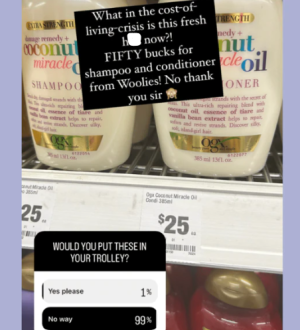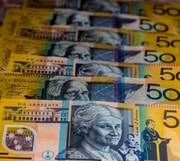Mum expresses shock at the price of basic bathroom staple at Woolies: ‘It's price gouging at its worst’
In an era where the cost of living is soaring, and every penny counts, it's no wonder that Australians are becoming increasingly vigilant about where their hard-earned money is going. Many of our members remember a time when the dollar stretched much further than it does today.
So, when a mum recently expressed her shock at the supermarket price of a basic bathroom staple, it struck a chord with budget-conscious shoppers everywhere.
The mum in question was left 'furious' after discovering the cost of her usual shampoo and conditioner had skyrocketed to a staggering $50.
Yes, you read that correctly—$50 for items that were once unassuming and affordable. It's a sum that would have once filled a shopping basket with a variety of goods but now barely covers two bottles of hair care products.

'It's price gouging at its worst,' the mum exclaimed, echoing the sentiments of many who feel the pinch of rising prices.
The term 'price gouging' is often thrown around, but what does it really mean? It refers to when a seller increases the prices of goods or services to a level much higher than is considered reasonable or fair, often during a demand spike or supply shortage.
This mum's experience is far from unique. Across the country, Australians are noticing that their dollar doesn't stretch as far as it used to, especially when it comes to grocery shopping.
A quick dash to the store for a few items can easily result in a bill that makes you double-take.
And it's not just shampoo and conditioner that are culprits; many everyday items have seen price hikes.
The frustration felt by this mum led her to conduct an impromptu survey on social media, where she found overwhelming agreement among her followers.
A whopping 99 per cent of the 340 respondents shared her outrage, with many questioning who would willingly pay such exorbitant prices for basic items.
‘Does anyone ever buy that at full price?’ someone asked.
Another stated: ‘Price gouging by the two supermarket giants. I’m going for the $7 for 500ml versions instead!’
The conversation around this issue is growing, with social media becoming a platform for venting and sharing stories of ‘daylight robbery’.
Just last week, a woman reported being charged $6.50 for a mini can of Coke at a cafe—a price that left many aghast.
The woman said: ‘What on earth is going on?! This is unbelievable… take-away kiosk and not even a proper full-size can of Coke!’
Based on the receipt provided, the woman paid $6.60 for a 250mL mini can of Coke and $9.35 for a 300mL bottle of juice. The total bill for the two drinks was $15.95, with an added 'handling fee' of $0.24, making the final amount $16.19.
It seems that everywhere we turn, prices are creeping up, and it's not just confined to the supermarket aisles.
So, what can we do about it? For starters, it's essential to be savvy shoppers.
Keep an eye out for specials and discounts, and don't be afraid to switch to more affordable brands when necessary.
Loyalty to a particular brand is commendable, but not when it comes at the cost of your wallet.
It's also worth considering bulk buying or shopping at discount outlets where prices tend to be more reasonable.
In these challenging times, it's more important than ever to make every dollar count.
While we may not be able to control the economy, we can control how we respond to it. By being informed, proactive, and vocal, we can ensure that we're not paying more than we need to for our everyday essentials.
 We'd love to hear from you, our Seniors Discount Club members. Have you noticed a significant increase in the price of your usual supermarket items? How have you adjusted your shopping habits in response? Share your experiences and tips in the comments below!
We'd love to hear from you, our Seniors Discount Club members. Have you noticed a significant increase in the price of your usual supermarket items? How have you adjusted your shopping habits in response? Share your experiences and tips in the comments below!
So, when a mum recently expressed her shock at the supermarket price of a basic bathroom staple, it struck a chord with budget-conscious shoppers everywhere.
The mum in question was left 'furious' after discovering the cost of her usual shampoo and conditioner had skyrocketed to a staggering $50.
Yes, you read that correctly—$50 for items that were once unassuming and affordable. It's a sum that would have once filled a shopping basket with a variety of goods but now barely covers two bottles of hair care products.

A mum shared her fury at the $50 price of a bottle of shampoo and conditioner. Image source: @lauracjackel/Instagram
'It's price gouging at its worst,' the mum exclaimed, echoing the sentiments of many who feel the pinch of rising prices.
The term 'price gouging' is often thrown around, but what does it really mean? It refers to when a seller increases the prices of goods or services to a level much higher than is considered reasonable or fair, often during a demand spike or supply shortage.
This mum's experience is far from unique. Across the country, Australians are noticing that their dollar doesn't stretch as far as it used to, especially when it comes to grocery shopping.
A quick dash to the store for a few items can easily result in a bill that makes you double-take.
And it's not just shampoo and conditioner that are culprits; many everyday items have seen price hikes.
The frustration felt by this mum led her to conduct an impromptu survey on social media, where she found overwhelming agreement among her followers.
A whopping 99 per cent of the 340 respondents shared her outrage, with many questioning who would willingly pay such exorbitant prices for basic items.
‘Does anyone ever buy that at full price?’ someone asked.
Another stated: ‘Price gouging by the two supermarket giants. I’m going for the $7 for 500ml versions instead!’
The conversation around this issue is growing, with social media becoming a platform for venting and sharing stories of ‘daylight robbery’.
Just last week, a woman reported being charged $6.50 for a mini can of Coke at a cafe—a price that left many aghast.
The woman said: ‘What on earth is going on?! This is unbelievable… take-away kiosk and not even a proper full-size can of Coke!’
Based on the receipt provided, the woman paid $6.60 for a 250mL mini can of Coke and $9.35 for a 300mL bottle of juice. The total bill for the two drinks was $15.95, with an added 'handling fee' of $0.24, making the final amount $16.19.
It seems that everywhere we turn, prices are creeping up, and it's not just confined to the supermarket aisles.
So, what can we do about it? For starters, it's essential to be savvy shoppers.
Keep an eye out for specials and discounts, and don't be afraid to switch to more affordable brands when necessary.
Loyalty to a particular brand is commendable, but not when it comes at the cost of your wallet.
It's also worth considering bulk buying or shopping at discount outlets where prices tend to be more reasonable.
In these challenging times, it's more important than ever to make every dollar count.
While we may not be able to control the economy, we can control how we respond to it. By being informed, proactive, and vocal, we can ensure that we're not paying more than we need to for our everyday essentials.
Key Takeaways
- A mother expressed her shock at the high cost of standard shampoo and conditioner at Woolworths, totalling $50, which she deems to be price gouging.
- The mum's social media poll showed overwhelming agreement, with 99 per cent of respondents supporting her view that the prices were too high for the bathroom staples.
- Social media has become a platform for Australians to voice their dissatisfaction with the perceived overpricing of everyday items in supermarkets and cafes.
- This comes after an incident where a woman paid $16.19 for two drinks at a Bondi cafe, reflecting broader concerns over rising costs and pricing practices in Australia.







